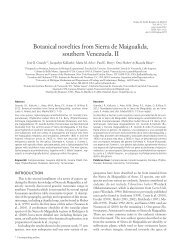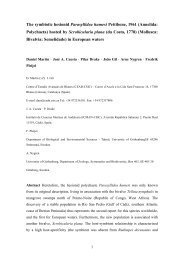- Page 1: INSTITUTO DE ACUICULTURA CONSEJO SU
- Page 5: The work presented in this Ph.D. Th
- Page 8 and 9: viii López Cabo do grupo de tecono
- Page 11 and 12: INDEX 1. INTRODUCTION: NEW STRATEGI
- Page 13 and 14: Index 5.3.2. Effect of pathogens co
- Page 15: Index 7.4. REFERENCES 172 8. ANNEXE
- Page 21: 1 INTRODUCTION This chapter has bee
- Page 24 and 25: 4 Immobilization of Phaeobacter 27-
- Page 26 and 27: 6 Immobilization of Phaeobacter 27-
- Page 28 and 29: 8 Immobilization of Phaeobacter 27-
- Page 30 and 31: 10 Immobilization of Phaeobacter 27
- Page 32 and 33: 12 Immobilization of Phaeobacter 27
- Page 34 and 35: 14 Immobilization of Phaeobacter 27
- Page 36 and 37: 16 Immobilization of Phaeobacter 27
- Page 38 and 39: 18 Immobilization of Phaeobacter 27
- Page 40 and 41: 20 Immobilization of Phaeobacter 27
- Page 42 and 43: 22 Immobilization of Phaeobacter 27
- Page 44 and 45: 24 Immobilization of Phaeobacter 27
- Page 46 and 47: 26 Immobilization of Phaeobacter 27
- Page 48 and 49: 28 Immobilization of Phaeobacter 27
- Page 50 and 51: 30 Immobilization of Phaeobacter 27
- Page 52 and 53: 32 Immobilization of Phaeobacter 27
- Page 54 and 55: 34 Immobilization of Phaeobacter 27
- Page 57 and 58: 2. BACKGROUND Phaeobacter 27-4 as p
- Page 59 and 60: Phaeobacter 27-4 as probiotic again
- Page 61 and 62: Phaeobacter 27-4 as probiotic again
- Page 63 and 64: Phaeobacter 27-4 as probiotic again
- Page 65: Phaeobacter 27-4 as probiotic again
- Page 69 and 70:
3. OBJECTIVES Objectives The main o
- Page 71:
Objectives 3.1.1. Growth and biofil
- Page 75 and 76:
4. CHAPTER I Chapter I. Real-time P
- Page 77 and 78:
Chapter I. Real-time PCR detection
- Page 79 and 80:
Chapter I. Real-time PCR detection
- Page 81 and 82:
Chapter I. Real-time PCR detection
- Page 83 and 84:
Chapter I. Real-time PCR detection
- Page 85 and 86:
Chapter I. Real-time PCR detection
- Page 87 and 88:
Chapter I. Real-time PCR detection
- Page 89 and 90:
Chapter I. Real-time PCR detection
- Page 91 and 92:
Chapter I. Real-time PCR detection
- Page 93 and 94:
Chapter I. Real-time PCR detection
- Page 95 and 96:
Chapter I. Real-time PCR detection
- Page 97:
Chapter II. Colonization and reside
- Page 100 and 101:
80 Immobilization of Phaeobacter 27
- Page 102 and 103:
82 Immobilization of Phaeobacter 27
- Page 104 and 105:
84 Immobilization of Phaeobacter 27
- Page 106 and 107:
86 Immobilization of Phaeobacter 27
- Page 108 and 109:
88 Immobilization of Phaeobacter 27
- Page 110 and 111:
90 Immobilization of Phaeobacter 27
- Page 112 and 113:
92 Immobilization of Phaeobacter 27
- Page 114 and 115:
94 Immobilization of Phaeobacter 27
- Page 116 and 117:
96 Immobilization of Phaeobacter 27
- Page 118 and 119:
98 Immobilization of Phaeobacter 27
- Page 120 and 121:
100 Immobilization of Phaeobacter 2
- Page 122 and 123:
102 Immobilization of Phaeobacter 2
- Page 124 and 125:
104 Immobilization of Phaeobacter 2
- Page 127:
6 CHAPTER III
- Page 130 and 131:
110 Immobilization of Phaeobacter 2
- Page 132 and 133:
112 Immobilization of Phaeobacter 2
- Page 134 and 135:
114 Immobilization of Phaeobacter 2
- Page 136 and 137:
116 Immobilization of Phaeobacter 2
- Page 138 and 139:
118 Immobilization of Phaeobacter 2
- Page 140 and 141:
120 Immobilization of Phaeobacter 2
- Page 142 and 143:
122 Immobilization of Phaeobacter 2
- Page 144 and 145:
124 Immobilization of Phaeobacter 2
- Page 146 and 147:
126 Immobilization of Phaeobacter 2
- Page 148 and 149:
128 Immobilization of Phaeobacter 2
- Page 150 and 151:
130 Immobilization of Phaeobacter 2
- Page 152 and 153:
132 Immobilization of Phaeobacter 2
- Page 154 and 155:
134 Immobilization of Phaeobacter 2
- Page 156 and 157:
136 Immobilization of Phaeobacter 2
- Page 158 and 159:
138 Immobilization of Phaeobacter 2
- Page 160 and 161:
140 Immobilization of Phaeobacter 2
- Page 162 and 163:
142 Immobilization of Phaeobacter 2
- Page 164 and 165:
144 Immobilization of Phaeobacter 2
- Page 166 and 167:
146 Immobilization of Phaeobacter 2
- Page 168 and 169:
148 Immobilization of Phaeobacter 2
- Page 170 and 171:
150 Immobilization of Phaeobacter 2
- Page 172 and 173:
152 Immobilization of Phaeobacter 2
- Page 174 and 175:
154 Immobilization of Phaeobacter 2
- Page 176 and 177:
156 Immobilization of Phaeobacter 2
- Page 178 and 179:
158 Immobilization of Phaeobacter 2
- Page 180 and 181:
160 Immobilization of Phaeobacter 2
- Page 183 and 184:
Final Discussion, Conclusions & Fut
- Page 185 and 186:
Final Discussion, Conclusions & Fut
- Page 187 and 188:
Final Discussion, Conclusions & Fut
- Page 189 and 190:
Final Discussion, Conclusions & Fut
- Page 191 and 192:
Final Discussion, Conclusions & Fut
- Page 193 and 194:
Final Discussion, Conclusions & Fut
- Page 195:
Final Discussion, Conclusions & Fut
- Page 199 and 200:
8. RESUMO EN GALEGO (ABSTRACT IN GA
- Page 201 and 202:
Anexo competencia por nutrientes li
- Page 203 and 204:
Anexo Phaeobacter 27-4 é inocua pa
- Page 205 and 206:
Anexo para os patóxenos da familia
- Page 207 and 208:
Anexo probióticos. As colonias de
- Page 209 and 210:
Anexo 8.5. Capítulo III: Aplicaci
- Page 211 and 212:
Anexo Austin, B., Brunt, J.W., 2009
- Page 213 and 214:
Anexo Huys, L., Dhert, P., Robles,
- Page 215:
Anexo Skjermo, J., Vadstein, O., 19

















